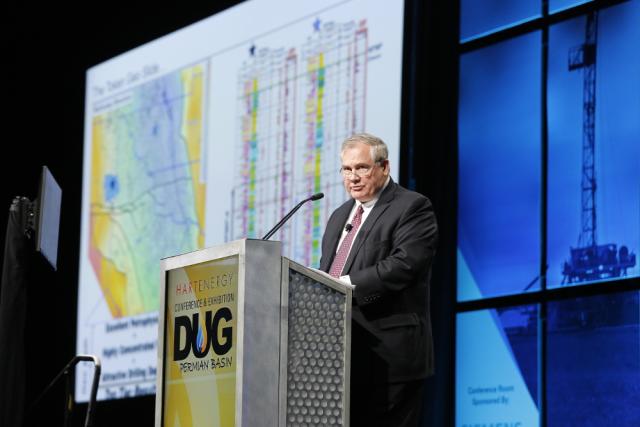
Admiral Permian Resources CEO Denzil West speaks about the company's assets April 16 during Hart Energy’s recent DUG Permian Basin Conference and Exhibition in Fort Worth, Texas. (Source: Tom Fox/Hart Energy)
FORT WORTH, Texas—In an oil and gas world filled with new technology, efficiency and operational gains, completion cocktails, production and drilling records plus M&A activity, it could be easy to lose sight of the end goal.
For Midland, Texas-based Admiral Permian Resources LLC, a privately-held E&P with assets in the Permian Basin’s Delaware, it’s about the money.
“I think a lot of us in the industry have overlooked the fact that we are not in the oil and gas business. We are in the money business,” Admiral Permian Resources CEO Denzil West said during Hart Energy’s recent DUG Permian Basin Conference and Exhibition. “That’s really what we’re here to do: make money.”
That even means squeezing value from gas assets, particularly when it comes to liquids-rich gas.
During Admiral’s first full year of production, the company—which formed in 2017—produced nearly 150,000 barrels of oil per day from a 1 ½-mile lateral with an additional 1.2 billion cubic feet of liquids-rich gas, West told conference attendees.
“That gas yields another 150,000 barrels of liquids the first year,” he said. “So all combined our liquids production for a typical Wolfcamp A well on our acreage set is over 300,000 barrels of oil and liquids the first year.” He later added the volume of gas and its ability to help drive production makes it a “really good asset.”
West admits, however, that nobody is happy with today’s natural gas prices. So, focus remains on execution and having repeatable drilling results.
Admiral, which has about 58,000 net contiguous acres in the western Delaware along the Reeves/Culberson county line, has reduced its cost per completed lateral foot by 33% while increasing frac intensity by 25% among other accomplishments, he said. Further savings have been realized by recycling 100% of water used and forging strategic long-term relationships with vendors in an area West said has been described by a competitor as a “combo” play—not gassy, but liquids-rich.
“We have very resilient break-evens. Even at $45 oil and nothing for gas…our individual well results in the Wolfcamp A are still yielding over a 20% rate of return,” he said. “We are excited because we feel like we have taken some acreage that was maybe dubiously thought of and proved it up.”
Admiral’s acreage set includes several wells previously drilled by ConocoPhillips Co. with marginal results, he said, noting areas to the south and west of the company’s acreage have proven to be challenging.
“But we went in and early in the process we started drilling a couple of pad wells and drilled Wolfcamp B wells under Wolfcamp A wells in a chevron pattern,” he said sharing the results.
“You can see extremely good results,” he said. “Our IP 30 on our first Wolfcamp B well was almost 700 barrels per day and about 11 million gas.”
Admiral is moving into full pad development in the Wolfcamp A and Wolfcamp B, and it has carried out some petrophysics work to evaluate potential above and below those zones.
Meanwhile, in a different part of the Permian Basin, another private E&P is proving that the Southern Midland Basin is just as attractive as the Northern Midland Basin, despite it having a reputation of being “gassier and potentially not quite as good.”
Steve Turk, CEO of Denver-based Discovery Natural Resources LLC, turned to a hypothetical case study of full-cycle returns comparing the south and the north.
“Admittedly the EURs, the percent oil [and] the wells per section advantage to the Northern Midland Basin,” Turk said, noting the south lacks a consistent Spraberry target. But the entry costs are lower in the Southern Midland and, at about $6.3 million, the cost to drill a 2-mile lateral is less than the $8 million needed in the Northern Midland.
“What this tells us is the higher oil content in the Northern Midland Basin is offset by our advantages of lower cost of entry, certainly lower drilling and completion costs as well as operating costs and an increased NGL uplift in the sale of our liquids,” Turk said.
VIDEO: DUG Permian 2019 Producer Panel Feat. Admiral Permian Resources, Discovery Natural Resources CEOs
In reality, Discovery—a private-equity-backed E&P formed in 2013—is proving its case on 110,000 net acres in the Southern Midland Basin, mostly in Reagan County and some in neighboring Irion County, with 825 producing wells.
“We have a 1,500-ft section of oil-soaked Wolfcamp,” Turk said. “Our oil-in-place over the extent of our acreage is roughly 150 million barrels per section.”
The company aims to increase production by 20% running two to three rigs this year, growing gross production from about 26,195 barrels of oil equivalent per day (boe/d) to about 32,000 boe/d. Plans also include expanding infrastructure to the northeastern and southeastern part of the company’s acreage as it moves into full field development, or “rolling development” as Discovery calls it.
“In rolling development, we build two pads and put two rigs on those pads and drill 10 to 12 wells. We move the rigs off and come in and complete those wells and then we move in next door and build an additional couple of pads and begin drilling those wells,” Turk explained. “At this time, we’ll turn on the first pad but leave the pad in between the new development area and the previously developed two pads dormant—that is not turning those online—to mitigate any parent-child issues that might be present.
“This allows us to simultaneously develop five different zones in the Wolfcamp-two in the A, two in the B and one in the C—and it also limits the parent-child impacts,” Turk added.

Like its peers, Discovery has also brought down costs. He said the company can now drill a 10,000-ft lateral and frack it with more than 2,000 lbs of sand per foot for about $6 million.
The work comes amid a resurgence of activity in this part of the basin following the market downturn and an exodus of some players to the north in 2015 and 2016, he said. But large operators are returning as frac learnings are being applied in the basin, he added.
“We really like the Southern Midland Basin. It’s an exceptional opportunity for Discovery and has a thick and consistent Wolfcamp section that’s 70-75% liquids-rich. Our takeaway capacity there is probably less constrained,” Turk said. “Certainly, we have a lower cost of entry. We have a lower oil-water ratio, which mitigates some of the saltwater disposal issues found in the Delaware Basin and the Northern Midland Basin and also our drilling and completion and operating costs are substantially lower than what you find in other parts of the Permian.”
Velda Addison can be reached at vaddison@hartenergy.com.
Recommended Reading
Defeating the ‘Four Horsemen’ of Flow Assurance
2024-04-18 - Service companies combine processes and techniques to mitigate the impact of paraffin, asphaltenes, hydrates and scale on production—and keep the cash flowing.
Tech Trends: AI Increasing Data Center Demand for Energy
2024-04-16 - In this month’s Tech Trends, new technologies equipped with artificial intelligence take the forefront, as they assist with safety and seismic fault detection. Also, independent contractor Stena Drilling begins upgrades for their Evolution drillship.
AVEVA: Immersive Tech, Augmented Reality and What’s New in the Cloud
2024-04-15 - Rob McGreevy, AVEVA’s chief product officer, talks about technology advancements that give employees on the job training without any of the risks.
Lift-off: How AI is Boosting Field and Employee Productivity
2024-04-12 - From data extraction to well optimization, the oil and gas industry embraces AI.
AI Poised to Break Out of its Oilfield Niche
2024-04-11 - At the AI in Oil & Gas Conference in Houston, experts talked up the benefits artificial intelligence can provide to the downstream, midstream and upstream sectors, while assuring the audience humans will still run the show.






